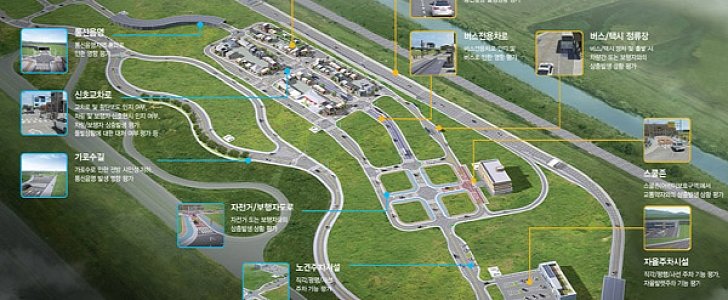South Korea’s government has officially announced it will open the largest test bed in the world meant for autonomous automobiles.
They call it K-City, and it can be used by developers of self-driving cars to experience real surroundings without any risks for regular citizens.
While the country will allow a few automakers to test autonomous cars on public roads as well, the new center will permit tests that will go further than merely driving on a public road.
The plan is to test several scenarios and situations that might occur in real life, and then repeat those tests with various conditions and modifications.
All the knowledge gathered will be employed to improve the existing and future systems for self-driving cars. The artificial city will simulate expressways, parking spaces, and bus-only zones.
Every aspect found in the average city will be implemented on the 360,000-square meter area, Business Korea informs. K-City was built according to the latest suggestions of intelligent transportation systems from the country’s Transportation Safety Authority.
While it sounds like a waste of money, think of it as an advanced laboratory that happens to be built on a real scale.
The United States of America already has a dedicated “city” for self-driving car tests, and it is located in the state of Michigan. It is called M-City, and it does something similar to K-City when we compare their descriptions, even if they do not come close to each other when size is concerned.
The facility will be opened in October, but its construction will be complete in the first half of next year. A big difference between K-City and public roads in South Korea will be the fact that vehicles without self-driving testing approval on public streets will be allowed to be employed there.
As long as nobody else’s property gets damaged by them, we do not see anything wrong. We would also not mind if all of the construction materials are not cleared from the streets of the simulated city, and a few potholes get introduced. After all, these driverless cars must be prepared for anything.
While the country will allow a few automakers to test autonomous cars on public roads as well, the new center will permit tests that will go further than merely driving on a public road.
The plan is to test several scenarios and situations that might occur in real life, and then repeat those tests with various conditions and modifications.
All the knowledge gathered will be employed to improve the existing and future systems for self-driving cars. The artificial city will simulate expressways, parking spaces, and bus-only zones.
Every aspect found in the average city will be implemented on the 360,000-square meter area, Business Korea informs. K-City was built according to the latest suggestions of intelligent transportation systems from the country’s Transportation Safety Authority.
While it sounds like a waste of money, think of it as an advanced laboratory that happens to be built on a real scale.
The United States of America already has a dedicated “city” for self-driving car tests, and it is located in the state of Michigan. It is called M-City, and it does something similar to K-City when we compare their descriptions, even if they do not come close to each other when size is concerned.
The facility will be opened in October, but its construction will be complete in the first half of next year. A big difference between K-City and public roads in South Korea will be the fact that vehicles without self-driving testing approval on public streets will be allowed to be employed there.
As long as nobody else’s property gets damaged by them, we do not see anything wrong. We would also not mind if all of the construction materials are not cleared from the streets of the simulated city, and a few potholes get introduced. After all, these driverless cars must be prepared for anything.

